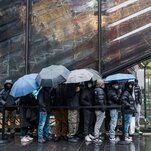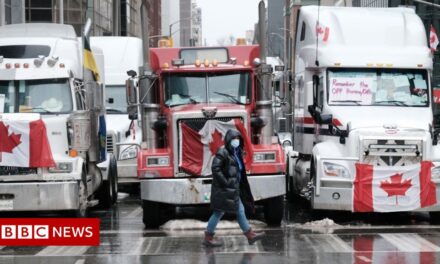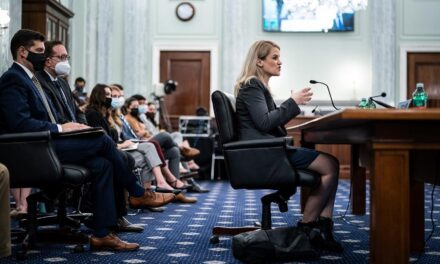
Black Friday Sees More In-Person Shopping (and Out-of-Stock Items)

Image

It’s easy to marvel at how consumers have continued to spend freely through the pandemic, propping up retailers and saving the economy from almost-certain disaster.
But as holiday shopping trends over the decades reveal, American shoppers have a history of spending more and more every year. Dating back to the middle of last century, holiday shopping has rarely declined from one Christmas season to the next.
Craig Johnson, the president of the retail research firm Customer Growth Partners, said holiday spending decreased annually during World War II and again during the depths of the great recession in November and December of 2008, when sales fell 4.7 percent. But those are the exceptions.
“It just never goes down,” Mr. Johnson said.
Mr. Johnson anticipates that consumers will spend 6.7 percent more than in 2020, when brick and mortar stores had barely emerged from lockdowns and vaccines were not widely available. And despite those serious obstacles last year, holiday spending still rose 8.2 percent from 2019.
There are, of course, new challenges this year: snarled supply chains, the highest inflation rates on food and other household staples in 30 years, and soaring gasoline and home heating prices.
But the fundamentals of high disposable incomes and Americans’ propensity to spend remain intact. Major retailers also seem to have found ways around the shipping and distribution delays and bolstered their inventories of popular gifts.
“Holiday spending has the potential to shatter previous records,” the National Retail Federation, the industry’s largest trade group, said in a statement last month.
The trade group estimated spending could rise as much as 10.5 percent this holiday season.
Image
Santa Claus is more comfortable around children. Stores are offering Champagne and musical performances. Fitting rooms are open and makeup counters will apply lipstick and blush to customers’ faces. The Macy’s Thanksgiving Day Parade was massively expanded.
With Black Friday as the symbolic start of the holiday shopping period, retailers in the United States are entering a buying season that is much more physically present than 2020, but not quite as carefree as it was prepandemic. People are far more comfortable shopping at stores, but the number who return will likely vary by geography, and the employees will typically be wearing masks.
Still, it is a sea change from last year’s long winter, and many shoppers appear excited for an in-person experience. When the NPD Group, a market research firm, surveyed more than 1,000 people about holiday traditions that they missed most in 2020 and hoped to resume, about 36 percent said they missed browsing retail stores.
One of the main challenges for retailers will be ensuring that they have items in stock.
Nordstrom said this week that it was facing a shortage of inventory at its off-price Nordstrom Rack chain as it grappled with production constraints and a reduction in clearance items. The retailer also said that it experienced inventory shortages more broadly in the third quarter, especially in categories like women’s apparel and shoes as customer demand returned stronger and faster than it anticipated. Nordstrom said, however, that it was in an improved position for the holiday season.
Gap said this week that it lost sales in the third quarter as products were limited by factory closings in Vietnam that lasted more than two and a half months and a backlog at U.S. ports. The company’s Old Navy chain was most affected by the delays. The company said it has ramped up its use of airfreight to get holiday products here in time. It is looking into canceling items that arrive too late, or holding them for next year’s holiday season.
Image
By Kevin Armstrong
PARAMUS, N.J. — Karl Tangara, a father of three, hurried into the Garden State Plaza mall’s east entry at 6:45 a.m. on Black Friday, pulled a handcart with three blue IKEA bags folded beneath a strap and approached Jay Daly, the mall’s senior general manager.
“Which way to the Lego store?” Mr. Tangara asked.
Mr. Daly pointed down the second-floor corridor with his two-way radio and detailed the path. Mr. Tangara thanked him and took off, passing customers standing in a long line at Lululemon, teenagers posing for selfies in front of Christmas decorations and workers vacuuming display windows before opening their doors.
“I just need Legos,” Mr. Tangara, 43, said. “Everything else I can do online.”
Customers returned to the Bergen County shopping center on a rainy morning for holiday discounts. At Morphe, the health and beauty store, signs advertised “ONE. BIG. SALE-A-BRATION.” with products going for up to 70 percent off. At Pacsun, there were reminders of the economy’s needs. A buy-one-get-one-free poster was displayed in the same window as two announcements that the store needed assistant managers.
“We’re expecting a fairly busy day,” Mr. Daly said as he watched the doors at Macy’s open.
Last year, government restrictions limited the mall to 50 percent capacity on the busiest day of the retail calendar, but there were no such limits this year. Christmas music played as shoppers moved from store to store, and a steady stream of patrons flowed in and out during the morning.
Mr. Tangara spent more than a half-hour in the Lego store. When he checked out, he had filled all three of his IKEA bags with gift boxes for his children and collectible sets for him and his wife. He was out the door by 8 a.m.
“I have another Thanksgiving with family,” he said, hauling his gifts into the parking lot.
-

Manhattan Gabriela Bhaskar/The New York Times -

The Mall of America in Bloomington, Minn. Tim Gruber for The New York Times -

New Orleans Annie Flanagan for The New York Times -

Macy’s Herald Square in Manhattan Gabriela Bhaskar/The New York Times -

Florence, Italy Clara Vannucci for The New York Times -

San Francisco, Calif. Jason Henry for The New York Times -

The Mall of America in Bloomington, Minn. Tim Gruber for The New York Times -

The Westfield Garden State Plaza in Paramus, N.J. Karsten Moran for The New York Times -

The Mall of America in Bloomington, Minn. Tim Gruber for The New York Times -

Castleton Square Mall in Indianapolis, Ind. Kaiti Sullivan for The New York Times -

Madrid, Spain Emilio Parra Doiztua for The New York Times -

Manhattan Gabriela Bhaskar/The New York Times -

The Westfield Garden State Plaza in Paramus, N.J. Karsten Moran for The New York Times -

Piazza della Repubblica in Florence, Italy Clara Vannucci for The New York Times -

The Mall of America in Bloomington, Minn. Tim Gruber for The New York Times
Image
Black Friday lures shoppers with the promise of deep discounts. But in reality, the biggest deals may have already happened.
The average promotional discount across major retailers heading into Black Friday is 33.4 percent, according to an analysis by Refinitiv, a financial data provider. That is lower than an average discount of 37 percent that was offered in October and the early part of this month.
The smaller Black Friday discounts reflect some of the larger forces at play in the retail industry this year. Problems with the supply chain have forced retailers to manage their inventory much more carefully. Anticipating problems with amassing enough popular items closer to Christmas, some companies have been trying to spread out their sales through the fall.
“Retailers were trying to relieve pressure on supply chains, so they pulled sales forward,” said Greg Portell, lead partner in the global consumer practice of Kearney, a strategy and management consulting firm.
Retailers are also struggling with higher costs because of those shipping issues and inflation, which makes them less willing to offer sales and cut into their profit margins further. Macy’s, Target and Kohl’s are all expected to see double-digit increases in “costs of goods sold” in the fourth quarter, according to Refinitiv.
More broadly, the timing of holiday shopping seems to know no bounds. Retailers have honed their data and analytics to know exactly when a customer might be willing to make a holiday-related purchase. For many, that timing may no longer coincide with the week after Thanksgiving or even the weeks leading up to Christmas.
“Consumers are being motivated to think about October purchases as holiday sales,” Mr. Portell said.
Image
Black Friday is an American import that has caught on in much of Europe, embraced by retailers and shoppers as an opening trumpet blast for the start of the holiday shopping season — even if Thanksgiving remains a distant country’s holiday.
But Black Friday takes shape in different forms. With toy stores as a focus, here are three snapshots of the state of Black Friday in Europe.
In Spain, the shopping season keeps shifting earlier.
Image
Early this week, Clara Pascual was preparing to pin a poster advertising a Black Friday sale onto the front door of her family-owned toy store in central Madrid.
Her store was empty of customers — which was no reason to worry, she said, because she expected most of her clientele to show up Friday and Saturday to take advantage of the 10 percent discount on toys purchased during her Black Friday event.
“For the past week or so, I think more people have been coming in to check that we were going to have a Black Friday special offer than to actually buy something,” said Ms. Pascual, whose store is called Hola Caracola, or Hello Snail.
For toy stores, Black Friday is a shift forward in their retail calendars, because the Spanish tradition is that children get their presents on Jan. 6, the feast of Epiphany, which celebrates how a star led the three kings to baby Jesus.
“We have already had to adapt to the fact that more Spanish families are gifting at Christmas than for the kings so that their children could enjoy their toys during a longer holiday spell,” Ms. Pascual said, “and now on top of that we know that many people will be buying their Christmas toys already on Black Friday — particularly this year as everybody has got worried about delivery problems.”
“Obviously Black Friday is a cultural import that has nothing to do with our own traditions and everything to do with globalization,” she said, “which is something that can you can welcome or not.”
Federico Corradini, the chief executive of XChannel, a marketing company that represents a dozen toy brands in Spain and Italy, said he expected their sales to triple this Black Friday compared with last year, buoyed by an increase in their ad spending.
“Most of our companies are placing a big bet on this Black Friday to sell as much as possible, also because they already know that they will have delivery troubles during the Christmas time,” he said.
In Italy, the appeal of serving customers in person.
Image
The Dreoni toy store has been a landmark in Florence, Italy, for 98 years, and it didn’t last that long without responding to new trends.
A few years ago, Italians started expecting big sales on a day called Black Friday, said Silvia Dreoni, a co-owner of the store and a member of the third generation to run it.
“We inevitably had to adapt,” she said. “We want to keep the pace with the times, and we embraced the Black Friday, like we did with Halloween.”
However, when translated to Italian the words suggested a collapse in the stock market. So the English term “Black Friday” stuck, marking its American roots.
Walking into Dreoni is magic for children and adults alike, with a ceiling painted to look like a blue sky crossed by puffy white clouds. A large puppet theater shows the Italian character of Pinocchio, the wooden puppet who dreams of becoming a real boy. The tale of Pinocchio was written by Carlo Collodi, who was born near the store.
About 10 years ago, Ms. Dreoni and her sister realized that their business needed a website, and their online store now showcases the 8,000 toys that they have on their shelves. But in-person sales provide more satisfaction, Ms. Dreoni said.
“Online sales are fine, but they are cold, no emotions,” she said. “Many people still like to touch a toy or have an expert explain it to them. It’s not like buying a pan or a pot.”
The surge in online purchases at this time of the year strains courier services across the country, making life difficult for smaller delivery companies.
Large national and international delivery companies have been swamped with online orders from Amazon and other e-commerce sites, said Marco Magli, owner of the ADL SPA Corriere Espresso, a local courier in Bologna. “Every day, we need to figure out who can help us deliver our goods in Milan or outside of the city” he said. “The market is totally saturated.”
“In the last couple of years, volumes of deliveries started going up already in November — whereas before it was only in early December” confirmed Massimo Pedretti, a union leader at SDA, a courier company owned by Italy’s postal service.
“It’s because of the Black Friday week,” he said.
In Germany, another holiday season can’t escape the pandemic.
Image
Record numbers of new coronavirus cases are dampening German shoppers’ spirits in a year when many were looking forward to the chance to return to holiday markets and decorated shopping streets.
In Bavaria, the closure of many holiday markets to curb the virus’s spread has turned out to be good for business atKunst und Spiel, or Art and Play, a store that specializes in German-made wooden toys and games.
“Our customers are happy that we are open,” said Florian Bartsch, who runs the store.
But given the current rate of infection, only 50 people are allowed at a time in the downtown Munich store, he added. And limited supplies are hindering sales. “Wooden toys are popular this year, although we are having trouble with deliveries,” Mr. Bartsch said. “All of the wholesalers are buying them up.”
Supplies of some locally sourced toys are still feeling the effects of the previous lockdowns, he said, including some items produced at a workshop for the handicapped in Germany.
“They were forced to close at the height of the pandemic last year and only recently got back to full production,” he said. “They are backed up by at least nine months.”
Fears that the shipping delays will make it harder to find last-minute gifts could drive up sales during Black Friday promotions by 27 percent over last year, the German retail association H.D.E. said this week.
At the start of November, the retail association was predicting a sales increase of 2 percent increase for the last two months of the year based on strong consumer sentiment heading into the holiday season. But the past two weeks have seen the country break one record after another in numbers of new infections, forcing authorities to close restaurants, bars and Christmas markets in the country’s eastern and southern states.
At Kunst und Spiel, Mr. Bartsch said that sales during the last three months of the year typically account for 70 percent of his annual business. After the loss he incurred during the lockdown in 2020, he is hoping he will be able to stay open, even if it means his staff has the added job of ensuring shoppers are vaccinated, masked and no more than 50 at a time.
“If our sales remain as they are so far, I will be happy,” he said.
Image
Retailers are expressing more concerns about robberies this year.
Best Buy said this week that its business was facing new pressure from organized crimes and thefts, and it was implementing new security measures in certain areas. One tactic includes putting QR codes on products behind lock-and-key. That allows customers to scan the codes and then check out, so associates don’t need to unlock the items right away.
“We are finding ways where we can lock up product, but still make that a good customer experience,” Corie Barry, Best Buy’s chief executive, said on an earnings call on Tuesday. “In some instances, we’re hiring security. We’re working with our vendors on creative ways we can stage the product.”
Still, she said, the pressure was visible in the company’s financials — she named it as one reason Best Buy saw a decline in its profit margin rate — and “traumatizing for our associates.”
About 69 percent of retailers said they had seen an increase in organized retail crimes in the past year, pointing to factors including the pandemic, policing, changes to sentencing guidelines and the growth of online marketplaces, according to a recent retail security survey from the National Retail Federation, an industry trade group. Respondents said that the groups involved have become more aggressive and violent.
This month, a group of about 80 people rushed into a Nordstrom store in Walnut Creek, Calif., outside San Francisco, and stole merchandise, with many escaping in speeding cars. There were also “smash-and-grab” robberies at other retailers in San Francisco around the same time, including Louis Vuitton, Saint Laurent and Burberry, according to The San Francisco Chronicle.
“Our priority has always been and will remain the safety of our people, whether that’s the pandemic, whether that is unruly customers, whether that is outright theft, which is a great deal of what we’re seeing right now,” Ms. Barry said this week. “This is a real issue that hurts and scares real people.”
Image
The term “Black Friday” has for years been synonymous with mayhem at stores, and its origin story has roots in turbulence.
Black Friday began in Philadelphia in the 1960s. Tourists would descend on the city on the day between Thanksgiving and the annual Army-Navy football game held on Saturday. Historians say the Philadelphia police took to calling the day Black Friday because officers had to work long hours and deal with terrible traffic, bad weather and other crowd-related miseries.
Local retailers wanted to draw in shoppers that day. But they disliked the term because of the connotation of the word “black” in front of a day of the week, which historically has been used to mark unpleasant events. One was Black Tuesday, the day of the stock market crash of 1929, and another, Black Monday, the day in 1987 when the market lost more, on a percentage basis, than on any day in 1929.
Retailers tried to rebrand the holiday “Big Friday” but were unsuccessful. Businesses later reclaimed the name Black Friday, saying that the day was when stores’ books went from red ink to black.
Retailers have tried more recently to spread the shopping frenzy across multiple days after a succession of injuries and even deaths as shoppers surged into stores in a blind rush for the day’s bargains. And because the holiday shopping season has become so important to retailers’ bottom lines, there is now Cyber Monday, the Monday after Thanksgiving that is being marketed as a day for online shopping, and Small Business Saturday, which encourages people to shop at local businesses.
This year, the season started long before Thanksgiving because of ongoing supply chain disruptions that rose out of the Covid-19 pandemic. Toys and electronics may not arrive in time for the holidays because of manufacturing and shipping delays. Many Americans have decided to start their holiday shopping ahead of Thanksgiving. The White House’s supply chain task force has been working with private companies to try to speed the flow of goods.
Gillian Friedman contributed reporting.
Image
Major retailers are opposing a vaccine mandate as they head into a bustling holiday season, fueled by concern about losing workers in a tight labor market, and betting that consumers will still feel comfortable shopping in stores even as Covid-19 remains a risk.
The industry showed how strongly it feels about the issue this month when the Biden administration directed companies with 100 or more workers to mandate vaccines or weekly tests for employees by Jan. 4. Five days after that announcement, the National Retail Federation, a major industry trade group, sued to stop the effort.
“We have a lot of stores that have a lot of openings, and any ruling that we have to mandate those colleagues be vaccinated prior to Christmas is just going to exacerbate our labor shortage going into a really critical period for us,” Jeff Gennette, Macy’s chief executive and a member of the national group’s board, said in an interview.
He said Macy’s would “love to see” the order put in place in the first quarter, which typically begins in February for the industry. That echoes the federation, which has said it wants to move the deadline back several months.
The move has been met with criticism from public health experts and some union leaders. The American Medical Association and the American College of Physicians put out a statement asking companies to move forward with the Labor Department rules.
“We’ve seen, throughout the pandemic, self-serving messages from employers who are putting profitability above their own employees’ health and safety,” said Stuart Appelbaum, president of the Retail, Wholesale and Department Store Union. “They have a misguided idea that it’s better for profits to take certain actions.”
The retail federation has estimated that retailers will hire up to 665,000 seasonal workers this year.
The administration’s order is now held up in litigation, challenged by a number of lawsuits from a broad coalition of opponents, and could make its way to the Supreme Court. Court filings by the administration warn that blocking the rule would “likely cost dozens or even hundreds of lives per day.”
Now-defunct department stores. Massive crowds. Bell-bottom jeans. Our photo editors gathered scenes of holiday shopping from the past 80 years. SEE THE PHOTOS →
Source: https://www.nytimes.com/live/2021/11/26/business/black-friday-2021


















